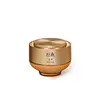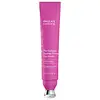What's inside
What's inside
 Key Ingredients
Key Ingredients

 Benefits
Benefits

 Concerns
Concerns

 Ingredients Side-by-side
Ingredients Side-by-side

Water
Skin ConditioningSqualane
EmollientPropanediol
SolventPolyglyceryl-3 Methylglucose Distearate
EmulsifyingDimethicone
EmollientGlyceryl Stearate
EmollientCetearyl Alcohol
EmollientHydrogenated Castor Oil Isostearate
Skin ConditioningBehenyl Alcohol
EmollientPhytosteryl Isostearyl Dimer Dilinoleate
EmollientNiacinamide
Smoothing1,2-Hexanediol
Skin ConditioningGlycerin
HumectantDiisostearyl Malate
EmollientButylene Glycol
HumectantPolyacrylate-13
Ammonium Acryloyldimethyltaurate/Vp Copolymer
Polyisobutene
Parfum
MaskingEthylhexylglycerin
Skin ConditioningDisodium EDTA
Angelica Archangelica Root Water
Skin ConditioningAdenosine
Skin ConditioningPolysorbate 20
EmulsifyingSorbitan Isostearate
EmulsifyingDextrin
AbsorbentTheobroma Cacao Extract
Skin ConditioningHydrogenated Lecithin
EmulsifyingPhytosphingosine
Skin ConditioningHydrolyzed Ginseng Saponins
Skin ConditioningSodium Polyaspartate
HumectantPanax Ginseng Root Extract
EmollientPanax Ginseng Seed Oil
EmollientSodium Methyl Stearoyl Taurate
CleansingGarnet Powder
AbrasiveGlycine Soja Extract
Skin ConditioningAspergillus Ferment
Skin ConditioningCaprylyl Glycol
EmollientTocopherol
AntioxidantAcetyl Heptapeptide-4
HumectantAcetyl Hexapeptide-8
HumectantSodium Hydroxide
BufferingAcetyl Octapeptide-3
HumectantWater, Squalane, Propanediol, Polyglyceryl-3 Methylglucose Distearate, Dimethicone, Glyceryl Stearate, Cetearyl Alcohol, Hydrogenated Castor Oil Isostearate, Behenyl Alcohol, Phytosteryl Isostearyl Dimer Dilinoleate, Niacinamide, 1,2-Hexanediol, Glycerin, Diisostearyl Malate, Butylene Glycol, Polyacrylate-13, Ammonium Acryloyldimethyltaurate/Vp Copolymer, Polyisobutene, Parfum, Ethylhexylglycerin, Disodium EDTA, Angelica Archangelica Root Water, Adenosine, Polysorbate 20, Sorbitan Isostearate, Dextrin, Theobroma Cacao Extract, Hydrogenated Lecithin, Phytosphingosine, Hydrolyzed Ginseng Saponins, Sodium Polyaspartate, Panax Ginseng Root Extract, Panax Ginseng Seed Oil, Sodium Methyl Stearoyl Taurate, Garnet Powder, Glycine Soja Extract, Aspergillus Ferment, Caprylyl Glycol, Tocopherol, Acetyl Heptapeptide-4, Acetyl Hexapeptide-8, Sodium Hydroxide, Acetyl Octapeptide-3
Water
Skin ConditioningDimethicone
EmollientPentylene Glycol
Skin ConditioningSilica
AbrasiveSqualane
EmollientUndecane
EmollientGlycerin
HumectantPyrus Malus Fruit Extract
Skin ConditioningTridecane
Perfuming1,2-Hexanediol
Skin ConditioningAmmonium Acryloyldimethyltaurate/Vp Copolymer
Cetyl Alcohol
EmollientPolyglyceryl-10 Laurate
Skin ConditioningPolyglyceryl-4 Caprate
EmulsifyingHydroxyacetophenone
AntioxidantPropanediol
SolventTridecapeptide-1
Skin ConditioningPalmitoyl Tetrapeptide-7
Skin ConditioningAcetyl Hexapeptide-8
HumectantArginine/Lysine Polypeptide
Skin ConditioningAcrylates/C10-30 Alkyl Acrylate Crosspolymer
Emulsion StabilisingSodium Phytate
Sorbitan Oleate
EmulsifyingDiosmine
AntioxidantColeus Forskohlii Root Extract
EmollientCaprylyl Glycol
EmollientXanthan Gum
EmulsifyingGlyceryl Caprylate
EmollientPseudoalteromonas Ferment Extract
HumectantTocopherol
AntioxidantWater, Dimethicone, Pentylene Glycol, Silica, Squalane, Undecane, Glycerin, Pyrus Malus Fruit Extract, Tridecane, 1,2-Hexanediol, Ammonium Acryloyldimethyltaurate/Vp Copolymer, Cetyl Alcohol, Polyglyceryl-10 Laurate, Polyglyceryl-4 Caprate, Hydroxyacetophenone, Propanediol, Tridecapeptide-1, Palmitoyl Tetrapeptide-7, Acetyl Hexapeptide-8, Arginine/Lysine Polypeptide, Acrylates/C10-30 Alkyl Acrylate Crosspolymer, Sodium Phytate, Sorbitan Oleate, Diosmine, Coleus Forskohlii Root Extract, Caprylyl Glycol, Xanthan Gum, Glyceryl Caprylate, Pseudoalteromonas Ferment Extract, Tocopherol
Ingredients Explained
These ingredients are found in both products.
Ingredients higher up in an ingredient list are typically present in a larger amount.
1,2-Hexanediol is a synthetic liquid and another multi-functional powerhouse.
It is a:
- Humectant, drawing moisture into the skin
- Emollient, helping to soften skin
- Solvent, dispersing and stabilizing formulas
- Preservative booster, enhancing the antimicrobial activity of other preservatives
Acetyl Hexapeptide-8, commonly known as Argireline or Acetyl Hexapeptide-3, is a popular peptide in skincare. It’s often referred to as a “Botox-like” ingredient because it helps reduce muscle movement.
By relaxing these micro-movements, Argireline may help minimize the appearance of fine lines and wrinkles. That said, it’s not as powerful as Botox, and research on its long-term effectiveness is still limited.
Beyond smoothing, Argireline may also support collagen production. Collagen is the protein that helps keep your skin firm, bouncy, and well-hydrated by strengthening the skin barrier.
So while Argireline isn’t a miracle fix, it can be a helpful addition to a routine focused on both prevention and skin health.
Read more about other common types of peptides here:
Learn more about Acetyl Hexapeptide-8Ammonium Acryloyldimethyltaurate/Vp Copolymer (let's call it AAVC for short) is a synthetically created polymer. It's used as a film-forming agent and used to thicken the consistency of products.
AAVC is able to increase the consistency and viscosity of products due to its large molecule size. It also prevents ingredients from separating.
Caprylyl Glycol is a humectant and emollient, meaning it attracts and preserves moisture.
It is a common ingredient in many products, especially those designed to hydrate skin. The primary benefits are retaining moisture, skin softening, and promoting a healthy skin barrier.
Though Caprylyl Glycol is an alcohol derived from fatty acids, it is not the kind that can dry out skin.
This ingredient is also used as a preservative to extend the life of products. It has slight antimicrobial properties.
Learn more about Caprylyl GlycolDimethicone is a type of synthetic silicone created from natural materials such as quartz.
What it does:
Dimethicone comes in different viscosities:
Depending on the viscosity, dimethicone has different properties.
Ingredients lists don't always show which type is used, so we recommend reaching out to the brand if you have questions about the viscosity.
This ingredient is unlikely to cause irritation because it does not get absorbed into skin. However, people with silicone allergies should be careful about using this ingredient.
Note: Dimethicone may contribute to pilling. This is because it is not oil or water soluble, so pilling may occur when layered with products. When mixed with heavy oils in a formula, the outcome is also quite greasy.
Learn more about DimethiconeGlycerin is already naturally found in your skin. It helps moisturize and protect your skin.
A study from 2016 found glycerin to be more effective as a humectant than AHAs and hyaluronic acid.
As a humectant, it helps the skin stay hydrated by pulling moisture to your skin. The low molecular weight of glycerin allows it to pull moisture into the deeper layers of your skin.
Hydrated skin improves your skin barrier; Your skin barrier helps protect against irritants and bacteria.
Glycerin has also been found to have antimicrobial and antiviral properties. Due to these properties, glycerin is often used in wound and burn treatments.
In cosmetics, glycerin is usually derived from plants such as soybean or palm. However, it can also be sourced from animals, such as tallow or animal fat.
This ingredient is organic, colorless, odorless, and non-toxic.
Glycerin is the name for this ingredient in American English. British English uses Glycerol/Glycerine.
Learn more about GlycerinPropanediol is an all-star ingredient. It softens, hydrates, and smooths the skin.
It’s often used to:
Propanediol is not likely to cause sensitivity and considered safe to use. It is derived from corn or petroleum with a clear color and no scent.
Learn more about PropanediolSqualane is an emollient that helps the skin hold onto moisture. It's an oily liquid that occurs naturally in certain types of fish and plant oils.
Because squalane boosts hydration in the skin, it also comes with plenty of benefits: it is an antioxidant and can help fight free radicals and skin damage. Squalane is also found to have a detoxifying effect when applied.
Squalane comes from squalene, which occurs naturally within the sebum of our skin. It is one of the oils our skin produces to keep itself hydrated. Squalane is the hydrogenated version of squalene and has a longer shelf life.
Research shows that squalane is non-irritating (even at 100% concentration).
In general, it's a fantastic ingredient. It does a great job at hydrating the skin, and it's suitable for those with sensitive skin.
The source of squalane may impact malassezia / fungal acne. This is because olive oil derived squalane can contain impurities such as fatty acids and plant waxes. Sugarcane derived squalane is recommended for anyone with malassezia concerns.
Is squalane vegan?
This depends on the source. Squalane can be derived from both plants and animals. Most squalane used in skincare comes from plants.
Please note: the source of squalane is only known if disclosed by the brand. We recommend reaching out to the brand if you have any questions about their squalane.
Read more about squalene with an "e".
Is squalane an oil?
Squalane is often called an oil, but it’s technically not; it’s a hydrocarbon, meaning it’s only made of carbon and hydrogen, unlike true oils which are triglycerides made of fatty acids and glycerol.
The term “oil-free” isn’t regulated, so companies can define it however they want. Some exclude all oils, while others just avoid mineral oil or comedogenic oils.
While some people avoid oils thinking they cause breakouts, the right kind of oil (or oil-like ingredient like squalane) can actually help balance and hydrate your skin. It’s worth testing out simple oils or squalane to see what works best for your skin.
Learn more about SqualaneTocopherol (also known as Vitamin E) is a common antioxidant used to help protect the skin from free-radicals and strengthen the skin barrier. It's also fat soluble - this means our skin is great at absorbing it.
Vitamin E also helps keep your natural skin lipids healthy. Your lipid skin barrier naturally consists of lipids, ceramides, and fatty acids. Vitamin E offers extra protection for your skin’s lipid barrier, keeping your skin healthy and nourished.
Another benefit is a bit of UV protection. Vitamin E helps reduce the damage caused by UVB rays. (It should not replace your sunscreen). Combining it with Vitamin C can decrease sunburned cells and hyperpigmentation after UV exposure.
You might have noticed Vitamin E + C often paired together. This is because it is great at stabilizing Vitamin C. Using the two together helps increase the effectiveness of both ingredients.
There are often claims that Vitamin E can reduce/prevent scarring, but these claims haven't been confirmed by scientific research.
Learn more about TocopherolWater. It's the most common cosmetic ingredient of all. You'll usually see it at the top of ingredient lists, meaning that it makes up the largest part of the product.
So why is it so popular? Water most often acts as a solvent - this means that it helps dissolve other ingredients into the formulation.
You'll also recognize water as that liquid we all need to stay alive. If you see this, drink a glass of water. Stay hydrated!
Learn more about Water